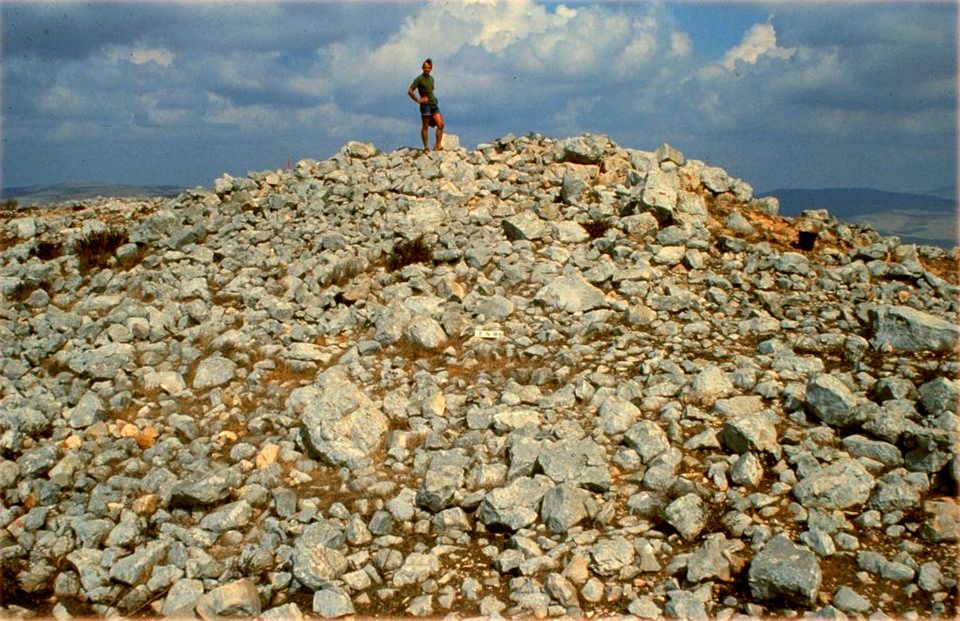
el-Burnat's large heap of stones
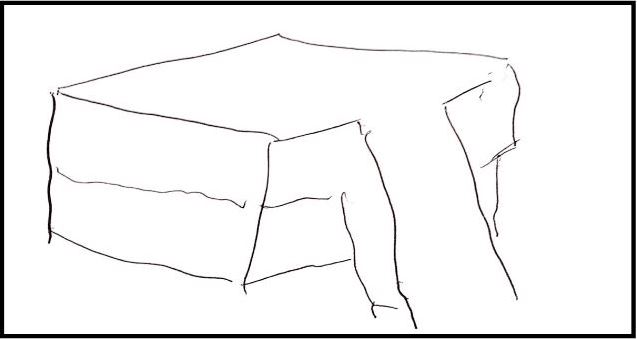
Zertal's drawing of the emerging structure
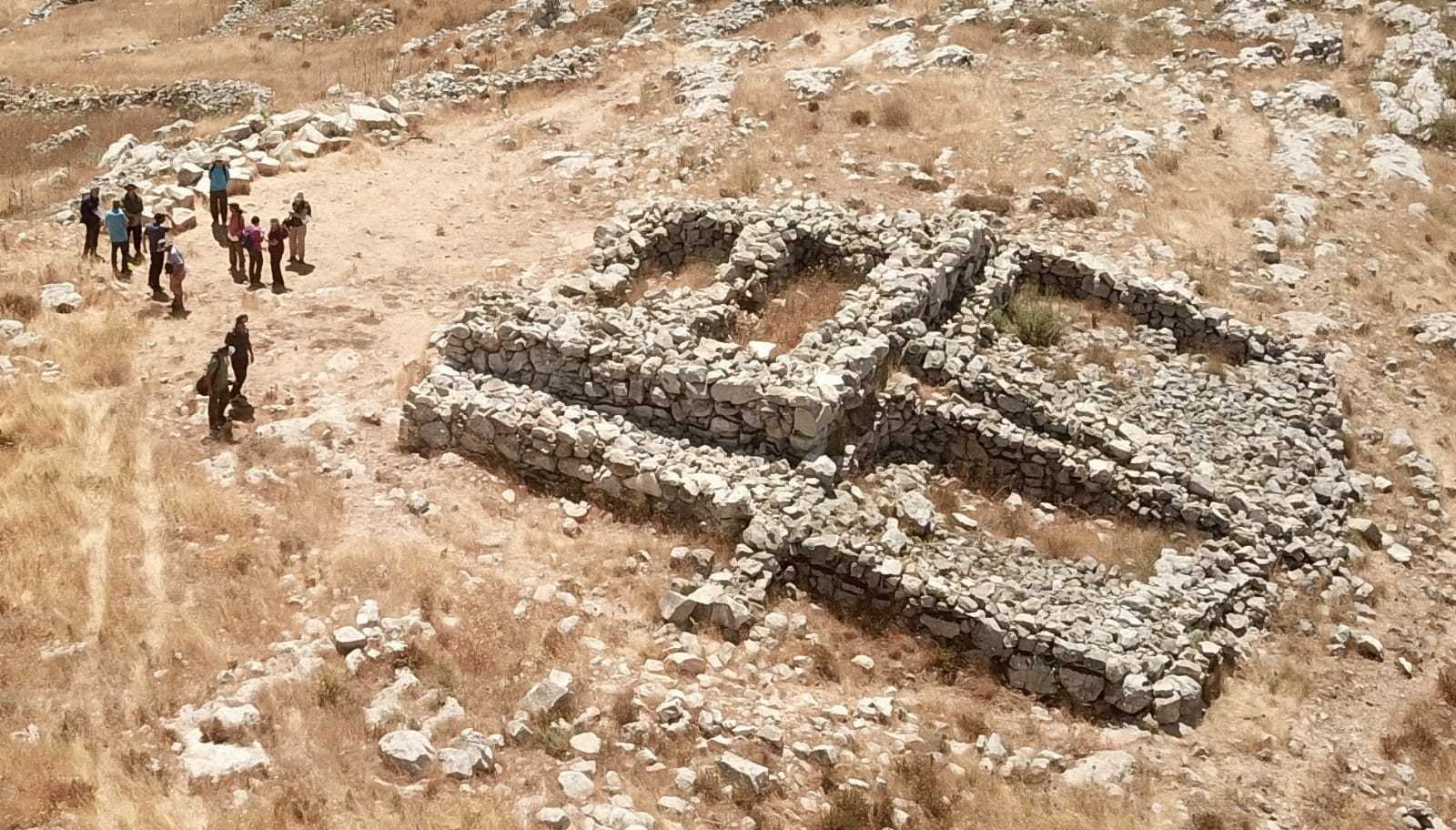
The uncovered archaeological site
Mount Ebal's Altar
Israeli archaeologist Adam Zertal was carefully evaluating and computer mapping an area on the northeastern
slope of Mt. Ebal, 200 feet from its summit and within a natural amphitheater, known as el-Burnat (Arabic: the
hat) for its pile of rocks resembling a hat.
The area was of interest for its a large quantity of pottery shards indicating human habitation dated when
the nation of Israel entered the Promised Land. Of all the known archaeological sites on Mt. Ebal, none were
dated this early.
Over the course of eight seasons (1982-89), Zertal uncovered a large unique altar and the earliest and most
complete Israelite cultic center ever discovered and the prototype for all later ones.
Significant features of the structure:
It is constructed with large uncut field stones.
Almost a square measuring 24.5 x 29.5 feet and almost 9 feet in height, two corners pointed
almost precisely north and south, and the other two corners almost exactly east and west.
The walls of the structure are 5 feet thick and laid directly on bedrock.
The structure had no floor or entrance to it and instead had a sloping ramp to the top of
the building.
The interior of the building was filled with layers of ash, including a large amount of
animal bones and bone ash, and stones. The animal bones, sent for analysis to the zoology department of the
Hebrew University in Jerusalem, were from young male bulls, sheep, goats and fallow deer. Most of the bones had
been burnt in open-flame fires of low temperature (200–600 degrees C.).
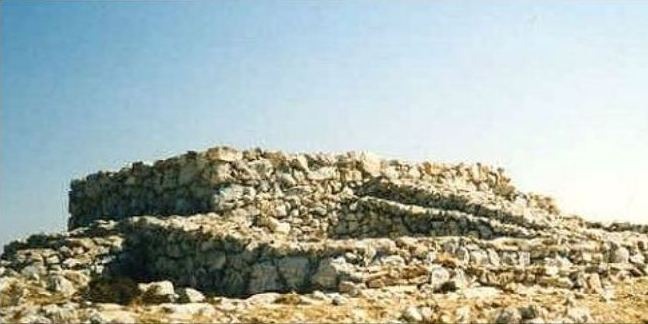
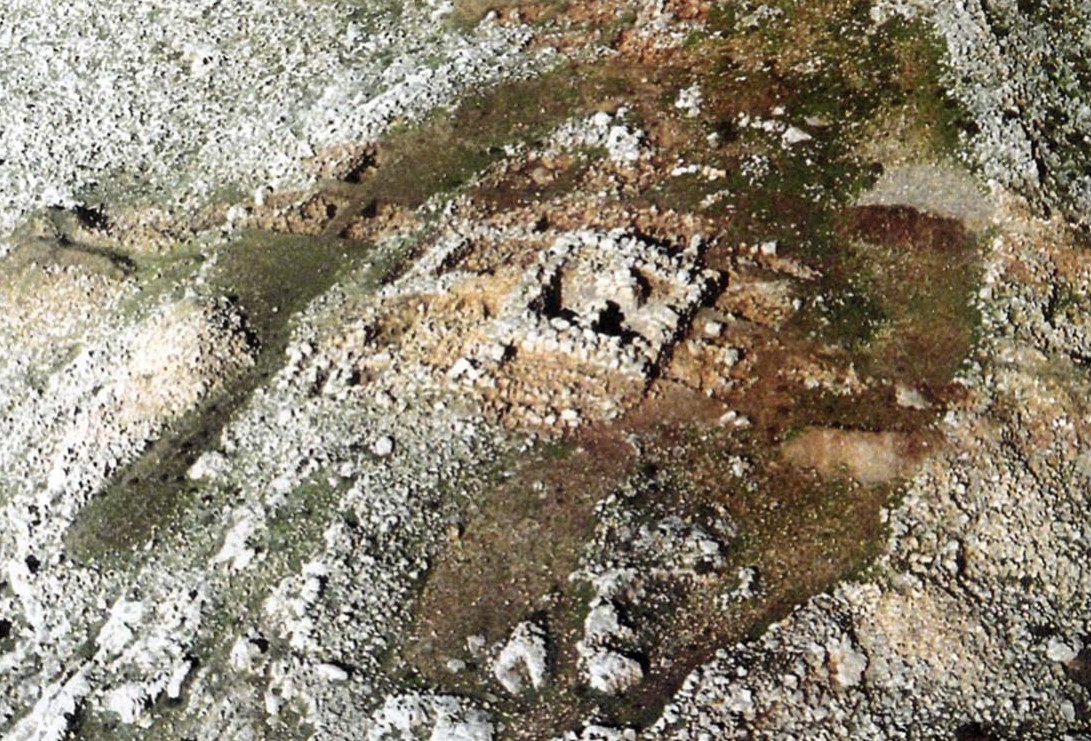
A student of Zertal's recognized that the drawing resembled a drawing of a Second Temple altar. With this
realization, the Bible was consulted and remarkably, the site's archaeological details corresponded to
Joshua's altar on Mount Ebal.
You shall make an altar of earth for Me, and you shall sacrifice on it your burnt
offerings and your peace offerings, your sheep and your oxen; in every place where I cause My name to be
remembered, I will come to you and bless you. And if you make an altar of stone for Me, you shall not
build it of cut stones, for if you wield your chisel on it, you will profane it. And you shall not go
up by steps to My altar, so that your nakedness will not be exposed on it.'
(Ex 20:24-26)
Just before entering the Promised Land, God instructs Moses on how to build an altar
specifically mentioning that it must not be comprised of hewn stones nor have steps leading up it. Joshua's
altar was built with field stones and with a sloping ramp for priests to access the top of the altar in keeping
with this design.
Now you shall make the altar of acacia wood, five cubits long and five cubits wide;
the altar shall be square, and its height shall be three cubits. You shall make its horns on its four corners;
its horns shall be of one piece with it, and you shall overlay it with bronze. And you shall make its pails for
removing its ashes, and its shovels, its basins, its forks, and its firepans; you shall make all its utensils of
bronze. You shall also make for it a grating, a netting of bronze, and on the netting you shall make four bronze
rings at its four corners. And you shall put it under the ledge of the altar, so that the netting will reach
halfway up the altar. You shall also make carrying poles for the altar, poles of acacia wood and overlay them
with bronze. Its poles shall be inserted into the rings, so that the poles will be on the two sides of the altar
when it is carried. You shall make it hollow with planks; as it was shown to you on the mountain, so they
shall make it. (Ex 27:1-8)
When God provides instructions on how to build the portable tabernacle altar, He states that
the altar should be "hollow with planks," as shown to Moses when he built the first altar at the foot of Mt.
Sinai (Ex 24:4-6). Joshua's altar was hollow and filled with
layers of ash, including a large amount of animal bones and bone ash.
God's instructions on burnt offerings specified young male unblemished bulls, lambs, and
goats (Lev 1:1-13). Joshua's altar contained bones of young
male bulls, sheep, goats and fallow deer.
Moreover, you shall build there an altar to the Lord your God, an altar of stones;
you shall not wield an iron tool on them. You shall build the altar of the Lord your God of uncut stones,
and you shall offer on it burnt offerings to the Lord your God; and you shall sacrifice peace offerings and eat
there, and rejoice before the Lord your God. You shall write on the stones all the words of this Law very
clearly." (Deut 27:5-8)
Then Joshua built an altar to the Lord, the God of Israel, on Mount Ebal, just as
Moses the servant of the Lord had commanded the sons of Israel, as it is written in the Book of the Law of
Moses, an altar of uncut stones on which no one had wielded an iron tool; and they offered burnt offerings on
it to the Lord, and sacrificed peace offerings. And he wrote there on the stones a copy of the Law of Moses,
which he had written, in the presence of the sons of Israel. (Josh 8:30-32)
Joshua was obedient to Moses' directive and built the altar on Mt. Ebal as specified.
Leviticus 3 describes the peace offering as an unblemished
animal, male or female, from herd or flock. In this prescription, a kosher animal such as a fallow deer may
qualify. When a lamb or goat is used, Leviticus 3 details
specific instructions.
When this finding was first published, there was vigorous debate whether this was indeed Joshua's altar on
Mt. Ebal. Skeptics dismissed Zertal's hypothesis and use of Bible. However, other explanations for the structure
such as a watchtower (Kempinski) or farmstead (Fritz, Rainey) have significant problems and no other explanation
has challenged Zertal's hypothesis.
Mount Ebal's Curse Tablet
During his excavation uncovering Joshua's altar on Mount Ebal, Adam Zertal dumped the discarded soil material
off site (1982-89). Over a two month period, the Associates for Biblical Archaeology conducted the Mt Ebal Dump
Salvage Project (Dec 2019-Jan 2020), which wet sifted the discarded excavation material in search of artifacts
that might have been missed by Zertal.
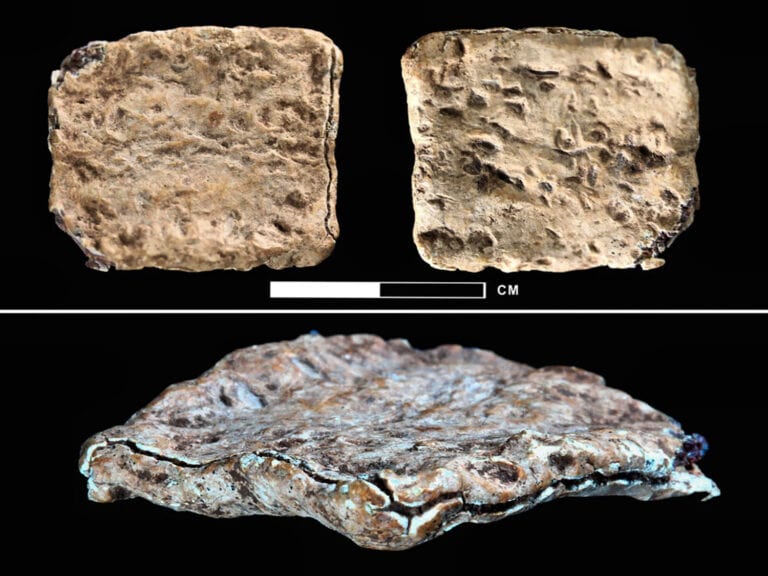
Front, folded back, and side views of the folded lead tablet
In the first month of sifting, a small lead tablet containing writing on both its inside and outside was
recovered.
Measuring less than 1 inch square, it was folded in half after being written. Analysis of the
lead found that it was mined in Greece during the Late Bronze Age (1550-1200 B.C.).
Deciphering the writing impressions required advanced digital scanning, which was carried out in Prague by
the Academy of Sciences of the Czech Republic.
Results from the scanning and 3-D imaging of the inside text found potentially up to 48
letters written in a meandering boustrophedon style.
Written in an archaic script resembling proto-Hebrew, researchers believe that the early Hebrew writing
dated to the Late Bronze Age II (1400-1200 B.C.).
Also supporting this view of early proto-Hebrew script is the finding of YHW (short for YHWH [Yahweh]).
The inscriptions, invoking curses by YHW, read:
You are cursed by the God YHW, cursed.
You will die, cursed – cursed,
you will surely die.
Cursed you are by YHW – cursed.
There are several important implications of this tablet finding:
1. The curse tablet was found on Mt. Ebal where God instructed Moses the tribes Reuben, Gad, Asher, Zebulun,
Dan, and Naphtali to stand and pronounce the curses for disobeying the Mosaic Covenant
(Deut 27:11-26). This supports Zertal's hypothesis that the
altar on Mt. Ebal is indeed Joshua's altar (Deut 27:1-26;
Josh 8:30-35).
2. The lead tablet material and proto-Hebrew script were consistent with the period of
Joshua as well as pottery shards recovered with it.
3. This is the earliest record of God's memorial name YHWH. The shortened version YHW
denotes an earlier archaic rendering.
4. The Mt. Ebal Curse Tablet provides archaeological evidence for Mosaic authorship of the
Pentateuch.
There is considerable academic debate about these inscriptions, which were impressions made with some type
of stylus upon the lead.
From experience studying a Czech lead amulet, researchers believed it possible to read the hidden text in
a lead artifact using X-ray tomography (XCT) since the tablet could not be unfolded.
In general, XCT of lead objects is a challenging task because of the strong scattering of
X-ray photons and the high attenuation of X-rays by lead.
Using software, CT reconstruction provided a 3-D rendering of the impressions.
Using those inscriptions incised inside the tablet that precisely matched the visible bulges seen on the
back of the tablet, researchers were able to observe which impressions were letters.
Through this process, researchers were able to draw the inscription to discern the letters.
Adam Zertal's discovery of Joshua's altar on Mt. Ebal appears to have significant support with the associated
finding of the Mt. Ebal Curse Tablet some thirty years later.
YHW clearly indicates that the Mt. Ebal Curse Tablet was of Hebrew origin!
The repeated use of the word "curse" coincides with Mt. Ebal as the location for pronouncing
God's curses for disobeying the Mosaic Covenant!
References:
1. Zertal, Adam, from the website: Biblicalarchaeology.org, Has Joshua's Altar Been Found on Mt. Ebal?
2. Steinmeyer, Nathan, from the website: Biblicalarchaeology.org, An Early Israelite Curse Inscription From Mt. Ebal?
3. Stripling S, Gershon G, Kumpova I, Valach J, Gert van der Veen P, and Vavrik D, from the website: Heritagesciencejournal.springeropen.com, "You are Cursed by the God YHW:" an early Hebrew inscription from Mt. Ebal.
Copyright ©
2024
Helpmewithbiblestudy.org. All rights to this material are reserved. We encourage you to print the material for personal and
non-profit use or link to this site. If you find this article to be a blessing, please share the link so that it may rise in
search engine rankings.